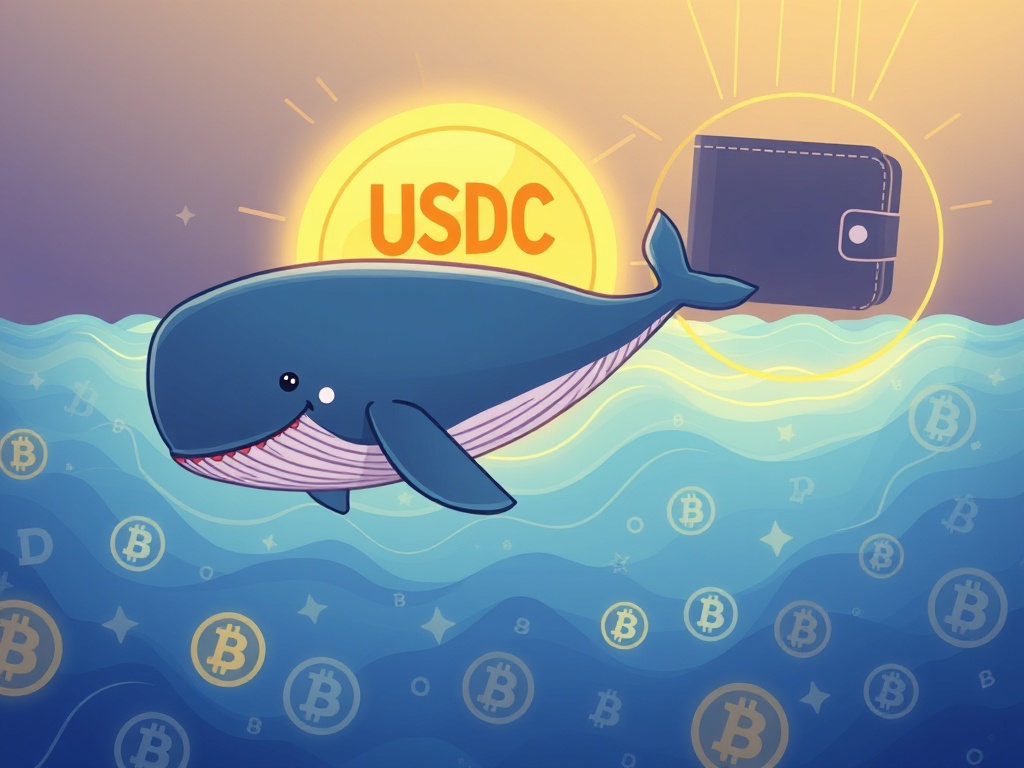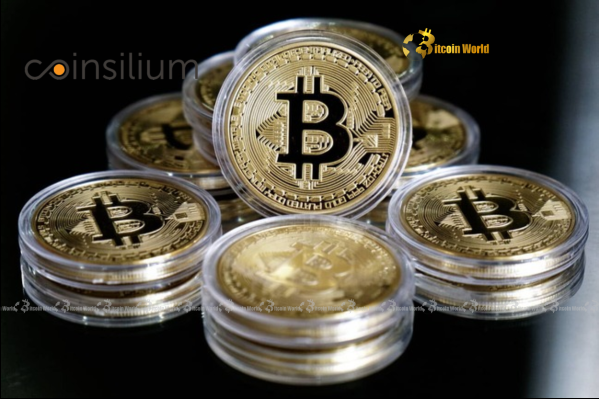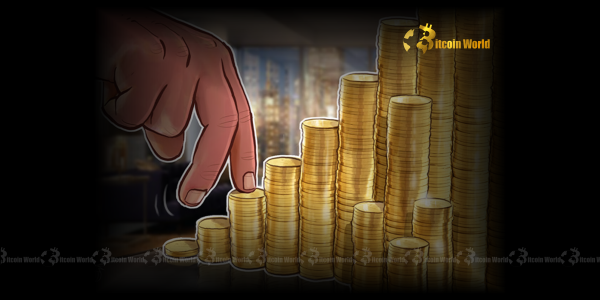BitcoinWorld

Massive USDC Transfer: Unpacking a $269 Million Crypto Movement
In the fast-paced world of cryptocurrency, moments of monumental activity often capture the attention of investors, analysts, and enthusiasts alike. One such event recently sent ripples through the digital asset community: a colossal USDC transfer. Imagine nearly $270 million, equivalent to the GDP of a small nation, moving across the blockchain in an instant. This is precisely what transpired when 269,164,935 USDC was transferred from Binance, one of the world’s largest cryptocurrency exchanges, to an unknown wallet. Such a significant USDC transfer isn’t just a number; it’s a signal, a mystery, and a potential indicator of larger market dynamics at play.
What Just Happened? The Colossal USDC Transfer Explained
The news broke courtesy of Whale Alert, a prominent blockchain tracking service that monitors large cryptocurrency transactions. Their report highlighted the movement of an astonishing 269,164,935 USDC, valued at approximately $269 million, from a Binance wallet to a destination currently identified only as an ‘unknown wallet.’ For those new to the crypto space, this might sound abstract, but it represents a significant shift of capital within the digital economy.
- The Sum: Nearly $270 million USD Coin (USDC).
- The Origin: Binance, a leading global cryptocurrency exchange known for its vast trading volumes and user base.
- The Destination: An ‘unknown wallet,’ which means the specific entity or individual behind the receiving address has not been publicly identified.
- The Tracker: Whale Alert, a service that provides real-time updates on large crypto transactions, offering transparency into the movements of ‘whales’ – individuals or entities holding substantial amounts of cryptocurrency.
This USDC transfer underscores the sheer scale and velocity with which digital assets can move across borders and between entities, often with a level of anonymity that sparks both fascination and debate.
Why Does a Large USDC Transfer Matter? Understanding Whale Movements
In the cryptocurrency ecosystem, a ‘whale’ is an individual or entity that holds a very large amount of a particular cryptocurrency. When these whales make significant moves, such as a massive USDC transfer, the market often pays close attention. Why? Because these movements can sometimes precede larger market shifts, indicate institutional activity, or simply reflect strategic decisions by major players.
While a stablecoin like USDC is designed to maintain a stable value (pegged 1:1 to the US dollar), large transfers of stablecoins are still noteworthy. Unlike volatile assets like Bitcoin or Ethereum, a large USDC transfer isn’t likely to directly impact the stablecoin’s price. However, it can signal:
- Preparation for Trading: Whales might move stablecoins to an exchange to prepare for a large purchase of other cryptocurrencies, or off an exchange to take profits or secure assets.
- Over-the-Counter (OTC) Deals: Large institutional trades often happen off-exchange through OTC desks to avoid market slippage. A large stablecoin transfer could be part of such a settlement.
- Exchange Rebalancing: Exchanges themselves might move funds between their hot and cold wallets for security or operational purposes.
- Institutional Inflow/Outflow: Major financial institutions entering or exiting positions often involve large stablecoin movements.
Understanding these ‘whale movements’ provides a glimpse into the underlying dynamics of the market, offering insights that go beyond simple price charts.
USDC: The Stablecoin at the Heart of the Transaction
The asset involved in this massive transaction is USD Coin (USDC), one of the most widely used and trusted stablecoins in the cryptocurrency market. But what exactly is USDC, and why is it so integral to the crypto economy?
USDC is a digital stablecoin pegged to the US dollar on a 1:1 basis, meaning one USDC is always intended to be worth one US dollar. It is managed by Centre, a consortium founded by Circle and Coinbase. Its primary purpose is to provide stability in the volatile crypto market, serving as a safe haven asset during periods of price fluctuations and facilitating easy transfers of value without the volatility of traditional cryptocurrencies.
Key characteristics of USDC:
| Characteristic | Description |
| Pegging | 1:1 to the US Dollar. |
| Backing | Fully backed by cash and short-dated U.S. government treasuries held in segregated accounts. |
| Transparency | Monthly attestations by independent accounting firms verify its reserves. |
| Utility | Used for trading, lending, borrowing, and cross-border payments. |
| Network | Primarily an ERC-20 token on Ethereum, but available on multiple blockchains. |
The robust backing and regulatory compliance make USDC a preferred choice for large institutional players and everyday users seeking a reliable digital dollar. The very fact that such a substantial USDC transfer occurred highlights its role as a fundamental building block in the global digital finance landscape.
Binance and the “Unknown Wallet”: Navigating Transparency in Crypto
The transaction’s origin from Binance, a global powerhouse in the crypto exchange space, immediately adds a layer of significance. Binance processes billions of dollars in trades daily and holds vast amounts of user funds, making its movements particularly scrutinized. When funds leave a major exchange like Binance for an ‘unknown wallet,’ it often raises questions about the nature of the recipient.
It’s important to clarify what an ‘unknown wallet’ typically means in the context of blockchain transactions:
- Not Necessarily Malicious: An ‘unknown wallet’ simply means the address is not publicly linked to a known entity (like another exchange, a specific company, or a famous individual). It does not automatically imply illicit activity.
- Cold Storage: Large amounts of funds are often moved from ‘hot’ exchange wallets (connected to the internet for liquidity) to ‘cold’ storage wallets (offline, for security) by exchanges or institutional investors. These cold wallets are typically unknown to the public.
- Over-the-Counter (OTC) Desks: As mentioned, large institutional trades often happen through OTC desks. The receiving wallet could belong to an OTC provider or a large institutional client.
- Private Wallets: It could simply be a private wallet belonging to a high-net-worth individual or a large investor who prefers to keep their holdings off exchanges.
While the blockchain offers transparency in tracking transactions, the identity of the wallet owner often remains pseudonymous. This balance between transparency of transactions and pseudonymity of participants is a core characteristic of decentralized finance and often a point of discussion regarding regulation and privacy.
Potential Reasons Behind This Massive USDC Transfer
When a whale moves nearly $270 million in USDC, speculation naturally arises. While the exact reason for this particular USDC transfer remains private, we can explore several common scenarios that might explain such a large movement:
- Institutional Onboarding or Offboarding: A major financial institution might be entering the crypto space by purchasing a large amount of USDC, or conversely, divesting a significant portion of their stablecoin holdings.
- OTC Trading Settlement: The funds could be settling a large over-the-counter trade, where a buyer acquired a substantial amount of another cryptocurrency (e.g., Bitcoin or Ethereum) and paid in USDC, or vice versa.
- Exchange Cold Storage Transfer: Binance itself might be moving funds from its operational ‘hot’ wallets to more secure ‘cold’ storage wallets to enhance security and manage liquidity. This is a routine security practice for exchanges.
- DeFi Protocol Interaction: A large entity could be deploying capital into a decentralized finance (DeFi) protocol for lending, borrowing, or yield farming, requiring a significant stablecoin deposit.
- Strategic Investment or Treasury Management: A corporation or large fund might be diversifying its treasury holdings into stablecoins for liquidity management or as a hedge against market volatility.
- Arbitrage Opportunity: While less likely for such a large, direct transfer to an unknown wallet, some large stablecoin movements are related to exploiting minor price discrepancies across different exchanges.
Each of these possibilities highlights the diverse and complex motivations behind large capital movements in the crypto world, showcasing the maturity and multifaceted nature of the digital asset market.
How Do Such Transfers Impact the Crypto Market?
The immediate impact of a large USDC transfer on the broader crypto market is often subtle, especially compared to the movement of volatile assets like Bitcoin. Since USDC is a stablecoin, its price is designed to remain constant. Therefore, this specific transfer won’t directly cause a price swing in USDC itself.
However, the indirect implications can be significant:
- Liquidity Signals: A large influx of stablecoins onto an exchange can signal an intent to buy other cryptocurrencies, potentially leading to upward price pressure. Conversely, a large outflow could suggest a desire to take profits or move funds off-exchange, which might be seen as bearish. In this case, the funds moved off Binance, suggesting a potential move into cold storage, OTC deals, or off-chain activities rather than immediate market buying.
- Market Sentiment: Large whale movements can influence market sentiment. While this particular transfer doesn’t immediately signal bullish or bearish intent, it reminds participants of the substantial capital flowing within the ecosystem.
- Confidence in Stablecoins: The continuous use and large transfers of USDC reinforce its role as a reliable medium of exchange and store of value within the crypto space, bolstering confidence in stablecoins generally.
- Regulatory Scrutiny: Large, seemingly anonymous transactions can sometimes attract the attention of regulators, fueling discussions around KYC (Know Your Customer) and AML (Anti-Money Laundering) compliance in the crypto industry.
Ultimately, while not a direct market mover, such a massive USDC transfer is a pulse check on the health and activity of the crypto market, offering insights into the behavior of its largest participants.
Protecting Your Assets: Lessons from Large USDC Transfers
While this particular USDC transfer involved institutional-level sums, it offers valuable lessons for every crypto holder, regardless of portfolio size. Understanding how large players manage their assets can inform your own security practices and investment strategies.
Here are some actionable insights:
- Diversify Storage: Just as exchanges use hot and cold wallets, consider diversifying how you store your crypto. Keep smaller amounts on exchanges for active trading (hot wallet) and larger, long-term holdings in secure hardware wallets (cold storage).
- Understand Stablecoins: Appreciate the role of stablecoins like USDC for stability, liquidity, and hedging against volatility. They are crucial tools in a balanced crypto portfolio.
- Be Aware of Market Signals: While not every whale alert is a direct trading signal, staying informed about significant on-chain movements can provide context for broader market trends.
- Practice Due Diligence: Always research exchanges, wallets, and protocols thoroughly before entrusting your funds. Ensure they have strong security practices and a proven track record.
- Prioritize Security: Use strong, unique passwords, enable two-factor authentication (2FA), and be wary of phishing attempts. Large transfers often highlight the critical importance of robust security measures.
The crypto world is dynamic, and vigilance is key. Learning from the actions of major players, even in a seemingly simple USDC transfer, can empower you to navigate this exciting landscape more safely and effectively.
The colossal USDC transfer of nearly $270 million from Binance to an unknown wallet is more than just a headline; it’s a testament to the scale and sophistication of the modern cryptocurrency market. While the exact intentions behind this particular movement remain private, it underscores the critical role of stablecoins like USDC, the operational intricacies of major exchanges, and the ongoing dance between transparency and privacy on the blockchain. Such whale movements, though not always directly impacting prices, serve as vital signals for market participants, offering glimpses into institutional activity, security practices, and the evolving landscape of digital finance. As the crypto economy continues to mature, understanding these massive transfers becomes increasingly important for anyone looking to navigate its complexities and harness its potential.
Frequently Asked Questions (FAQs)
1. What is a crypto whale?
A crypto whale is an individual or entity that holds a very large amount of a particular cryptocurrency. Their transactions, like a significant USDC transfer, can sometimes influence market sentiment or indicate larger strategic moves due to the sheer volume of their holdings.
2. What is USDC and why is it important?
USDC (USD Coin) is a stablecoin pegged 1:1 to the US dollar, meaning its value is designed to remain stable at $1. It is important because it provides stability in the volatile crypto market, facilitates fast and cheap transactions, and is widely used for trading, lending, and as a safe haven asset.
3. Why are large transfers to “unknown wallets” common in crypto?
Large transfers to “unknown wallets” are common because these often represent movements to secure cold storage, settlements for over-the-counter (OTC) trades, or transfers to private institutional wallets. The term “unknown” simply means the wallet address isn’t publicly attributed to a specific person or entity, not necessarily that the transaction is illicit.
4. Does a large USDC transfer affect USDC’s price?
No, a large USDC transfer typically does not affect USDC’s price. As a stablecoin, USDC is designed to maintain a 1:1 peg with the US dollar, backed by reserves. Its value is not subject to the same supply and demand dynamics that influence the prices of volatile cryptocurrencies like Bitcoin or Ethereum.
5. How can I track large crypto transactions like this one?
You can track large crypto transactions using blockchain explorers and services like Whale Alert. These platforms monitor public blockchain data and report significant movements of various cryptocurrencies, providing insights into whale activity and market trends.
6. Is Binance safe for large crypto holdings given these transfers?
Binance is one of the largest and most widely used cryptocurrency exchanges globally, employing extensive security measures, including cold storage for the majority of user funds, insurance funds, and robust compliance protocols. While no platform is entirely risk-free, Binance continuously invests in security to protect user assets. Large transfers from exchanges often indicate internal security practices (like moving to cold storage) rather than a security breach.
Did you find this deep dive into the massive USDC transfer insightful? Share this article with your friends, family, and fellow crypto enthusiasts on social media to spread awareness about the fascinating world of cryptocurrency whale movements!
To learn more about the latest crypto market trends, explore our article on key developments shaping stablecoin adoption and institutional interest.
This post Massive USDC Transfer: Unpacking a $269 Million Crypto Movement first appeared on BitcoinWorld and is written by Editorial Team





